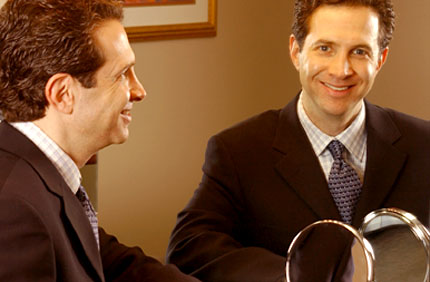|

|
|
|
|
 SETH YELLIN SETH YELLIN |
|
About face!
Plastic surgery gains wider acceptance
When Mary Ellen Medici was a teenager in Boston, she took full advantage of summer days by covering her skin in baby oil and iodine and spending as much time in the sun as possible. In her early forties, Medici started having some serious regrets about her youthful indiscretion.
“My skin was really damaged from the sun. I had age spots, and the skin on my face was dry and old looking. I had wrinkles around and underneath my eyes,” says Medici, who lives in Fayetteville with her husband and two sons.
After a friend had an eye lift, Medici started considering cosmetic surgery and scheduled a consultation with Seth Yellin ’84C, director of the Emory Facial Center.
“Like it or not, we live in a society that puts great value on appearance,” says Yellin. “One’s self-image is critical. Attractive, confident people have a social advantage. Most of my patients are already attractive. But they want to regain their youthful advantage.”
Like Medici, who decided on a laser resurfacing of her face and an eye lift, more people are turning to surgery to enhance their appearance, correct perceived flaws, or reduce signs of aging.
Almost nine million Americans had cosmetic surgery last year, with the top five procedures being rhinoplasty (nose job), liposuction, breast augmentation, eyelid surgery, and face lift.
Yellin’s practice increased by 36 percent last year, mirroring the national surge.
“Television has done a lot of good in terms of demystifying plastic surgery, taking it out of the realm of the privileged and bringing it to the masses,” says Yellin. “But it also sets up false or unrealistic expectations. Makeover shows spend a long time searching for people who are just right, and who will show a dramatic change.”
He adds, “These are real surgeries with real risks and real scars.”
Yellin, who gained his medical degree at New York University, says his skills as a plastic surgeon—suture techniques, knowing how much and in which direction to pull, where to create an indention—were gained on the job. “Plastic surgeons,” he says, “must have a well-developed aesthetic of what makes a face beautiful.”
About three-fourths of his practice is cosmetic surgery; the remainder is reconstructive. Yellin is also chief of facial plastic surgery and co-director of Emory’s Pediatric Head and Neck Center, where he operates on children with cleft lips or microtia, a congenital ear deformity. He performed two corrective surgeries on seven-year-old microtia patient Alexandria Head, of Smiths, Alabama. “When she was in preschool, other kids started noticing, and Alex started asking why her ear was smaller,” says her mom, Tiffany Head. “But now, she’s very confident about it. She wears ponytails, and tucks her hair behind her ears.”
A youthful looking forty-three, Yellin hasn’t had any cosmetic surgery personally but he does give himself Botox injections periodically. “I used to have two deep lines right between my eyes, which made me seem intense and serious,” he says. “People react to me completely differently now. They see me as lighter and more approachable.”
Rosemarie Garland-Thomson of the Department of Women’s Studies says people are more aware of their appearance today. “This has changed drastically over the last hundred years, with scales, full-length mirrors, cameras, video. Before these instant images, we weren’t able to scrutinize what we look like in the same way we are now. Our commercial culture has more of everything, which includes more arenas for the enhancement and presentation of self. This is both exciting and disturbing.”—M.J.L.
|
|
| |
©
2005 Emory University
|
 |
 |
 |
 |
 |
|